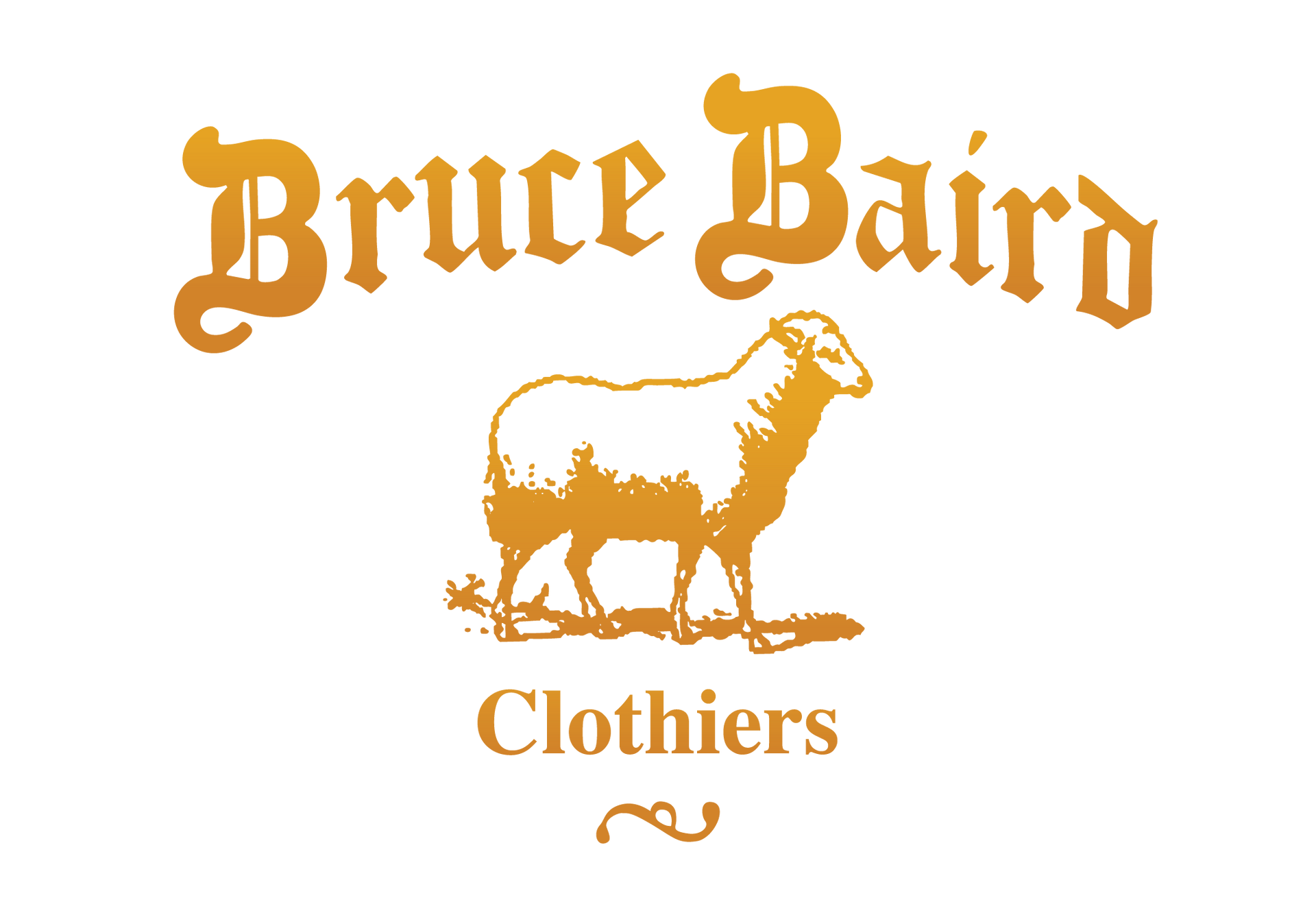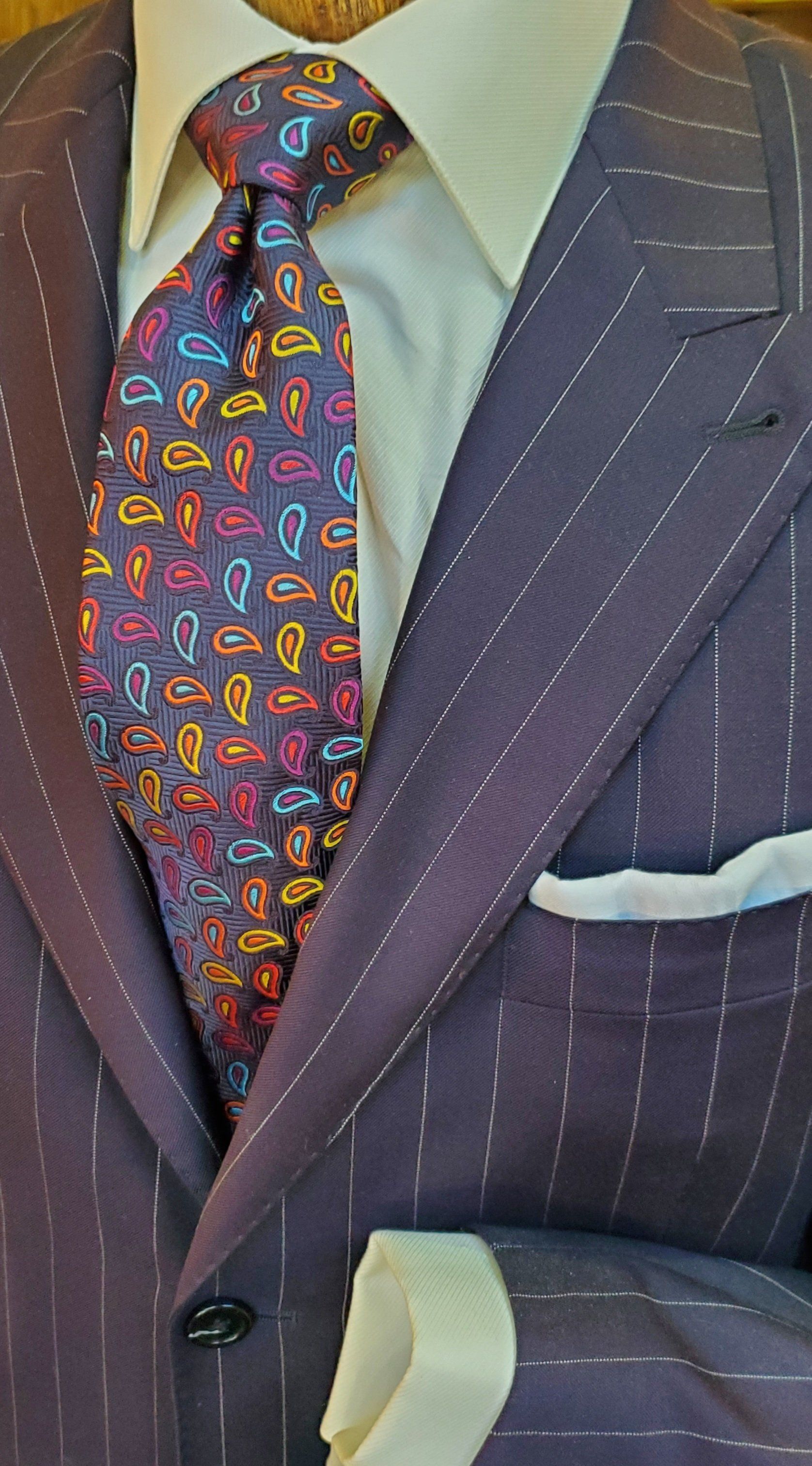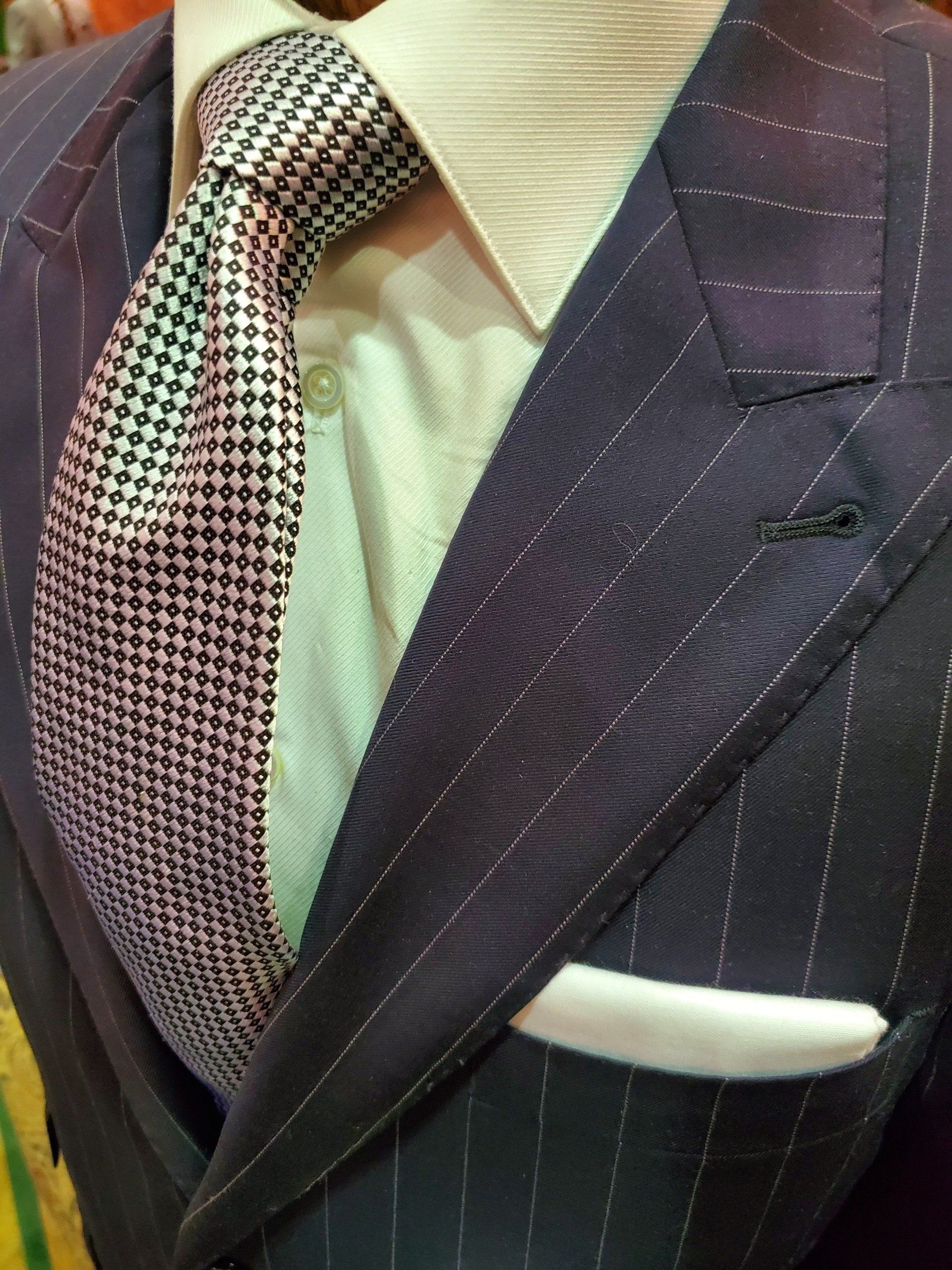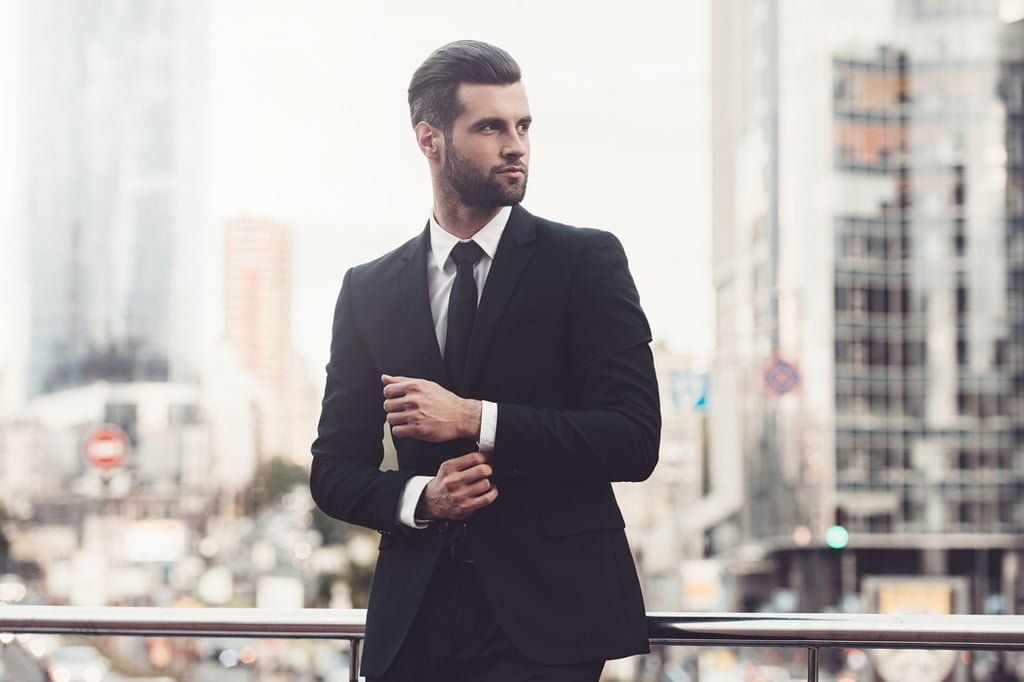Clothing Terms 101
Richmond Truex • August 10, 2020
What does that mean?
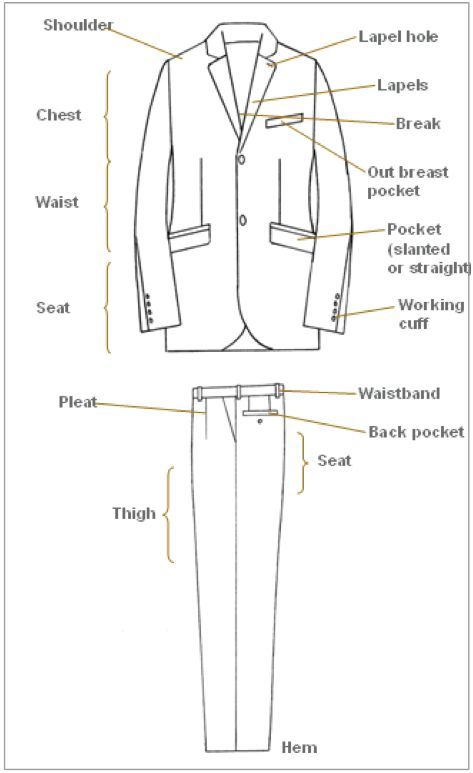
The basic terms describing features and construction elements in clothing can be difficult. These terms are also intricate in the measuring process for your bespoke or off the rack suit as well as shirts and trousers. Some of the most common measurements and pieces of a suit are visually explained in the above picture. Following are basic terms every man should know and what they mean.
- Lapel - The folded fabric on the front of a suit jacket. It's usually notched or peak and should be in proportion, width-wise, to your tie.
- Thread Count - This does exactly what it says on the tin. The thread count measures the exact amount of threads per one square inch of fabric. It’s always best to go for a relatively high thread count, from 100-120, as this ensures that the material will be soft yet durable. If you start going above 200 for your thread count, then you should probably reconsider, as this much finery is likely to make the fabric a lot less durable.
- Shawl Collar - A type of lapel with no notch or fold. A shawl collar, also known as a shawl lapel, runs unbroken from the top of the collar to the buttons.
- Bespoke - A piece that has been crafted to the customer's specifications. The client is measured and has the option to choose everything from fabric to stitching.
- Black-tie - Code word for a completely black tuxedo with a white formal shirt and a black bow and cummerbund set. Depending on the lapel, match the grosgrain or satin to your cummerbund set added. Brace are a plus to hold up your pants and for comfort. Black socks and black patent leather shoes are non-negotiable for black-tie.
- Button down - A button-up shirt with a button-down collar.
- Pleat- Stitched and folded fabric that forms a permanent crease on pants. Pleats are timeless in the correct model. A standard cut is more appealing than the relaxed fit.
- Break - How much of the bottom of a pair of trousers fold where they meet your shoes. A full break is a lot of folding; no break is not folding at all. Breaks are a matter of personal taste, but medium breaks are most common. While less of a break can yield a slimming look, if you're still getting a sense of your personal style, a medium break is a safe choice.
- Yoke - The shaped section along the shoulders of a dress shirt that connects all the other parts of the shirt. One-piece yokes are common on off-the-rack dress shirts. Split yokes place a seam in the vertical center of the shoulder. Often, the two pieces of the split yoke are rotated at an angle, creating a chevron pattern when a striped or checked fabric is used. This can be beneficial for two reasons. First, custom shirtmakers can potentially adjust each side to accommodate asymmetrical shoulders, but more importantly traditional non-stretch fabrics offer more give when pulled at an angle than when pulled vertically or horizontally, allowing greater comfort with movement. More practically, it's a style preference as the resulting pattern can complement a man's v-shape, and is a more formal look.
- French Cuffs- Twice as long as regular or “button” cuffs, french cuffs (or “double cuffs”) fold back and fasten with cufflinks or fabric knots. French cuffs lend an air of formality to an outfit, and are usually worn with suits or tuxedos. The French Cuff actually originated in Britain. It didn't gain its current name until it became a trend in America in the 1930s. The cuffs were viewed as luxurious and sophisticated, and became identified with French fashion. French cuffs can be worn with a blazer or jeans, but make sure that you have considered ways to make the look less formal. For example, fabric knots instead of cufflinks might do the trick.
- Gauntlet button - A button placed halfway down the placket of the sleeve. This button maintains the sleeve's tailored appearance, but allows the shirt to be rolled above the elbow when unbuttoned.
- Gusset - A triangular or rhomboidal piece of fabric inserted at a seam to add strength and durability to a garment and reduce wear and tear. In men's formal wear, you'll often see a gusset in the underarm of a dress shirt. On casual shirts, this is the triangular piece present on the bottom side of the hem.
- Braces - A British term that refers to what Americans call “suspenders.” Sartorially correct braces are pieces of fabric (sometimes silk, sometimes not) that sit on the shoulders and attach to the trousers’ waistband via buttons to hold them up. Clip-on braces are incorrect.
- Vent - The slit you see on the backside of blazers, sport coats, suit jackets, and any other type of jacket. Two types are center vent and side, The purpose of a vent is to allow the suit jacket to fall over the back of a seat or stool, and help you avoid sitting on your jacket. The vent originated as a way to help men comfortably ride horses. However, they did not become standard in formalwear until after World War 2, when horsemanship was on the decline.
- Nap -The raised surface found projecting from a fabric. Napping can be produced intentionally (by brushing) or naturally (during weaving). The most common “napped” fabrics we wear include flannel and wool. In addition to a relaxed, rustic look, napping also provides additional warmth.
- Warp -Warp is the vertical threading of a garment. In contrast, “weft” is the horizontal threading.
- Bi- Swing Back - Found in casual sport jackets, these have vertical inverted pleats running from shoulder to waistline on each side of the back. Often paired with a stitched-on half belt in back.
- Half Back - -A tailoring term that refers to the distance between a jacket’s center seam and where its side and sleeve seams intersect.
- Surgeon Sleeves - Surgeon's sleeves, or cuffs, refer to functional buttons on a suit jacket sleeve. These buttons are often decorative on suit jackets today. Surgeon cuffs are a symbol of quality. When wearing jackets with surgeon cuffs, men will often leave the final button unbuttoned as a nod to sartorial tradition. Bespoke tailors sometimes build a contrasting thread into the final buttonhole to emphasize the surgeon's cuffs. The cuffs are named for Civil War era surgeons, who wanted to work all day without bloodying the arms of their coat.
- Chalk stripe - Vertical lines on a suit fabric, designed to look like the colour of tailor's chalk. The lines are subtle and hazy compared to the crisp, distinct lines of pinstripe.
- Peak lapel - The peak lapel creates an aggressive - yet rakish - upward point towards the shoulder; emphasising the already dramatic 'V' silhouette (especially when used on double-breasted cuts) and helping elongating the wearer's frame.
- Pinstripe- Narrow, crisp lines running in parallel, found in cloth often used for suiting. Originally called a coach line, the pattern is evenly woven into fabric generally spaced one half to one inch apart.
- Goodyear welting - A method of shoe construction in which the insole, upper, and welt are sewn together. The welt is then stitched to the outsole as to leave the upper surface of the insole free of tacks and stitches. This method allows for resoling and is virtually waterproof.
- Shank - A steel spring doe 4 inches [10 cm] long and three-fifths of an inch [1.5 cm] wide that strengthens the region of the waist in the gap formed by the welt and the insole. It stiffens this part of the shoe, which must not move when walking.
- Slanted Pockets - Pockets set diagonally instead of horizontally. Also known as "hacking" pockets in England.
- Three- rolls - two - Also called a three-two or a false three. A hybrid of a two-button and a three-button jacket. A three-rolls-two has three buttons, but the lapel is shaped to roll as above the second button but below the third button, which hides the top (third) button under the roll. A classic choice preferred by many suit aficionados for both sport coats and suits, the third button is not used.
- Ticket Pocket - A narrow, single pocket set above a flap pocket on the right side of the jacket. Uncommon on ready-to-wear suits, the ticket pocket has been around for many decades and continues to be a good choice both for slanted or straight pockets.
- Neck Slope - An alteration in bespoke shirts that "drops" the collar at the front placket. This ensures the man having no neck comfort. Because of the construction, only 1/2" is the maximum allowed amount.
- Bias - - A garment is said to be “cut on the bias” when the a woven fabric is cut at a 45-degree angle. Any necktie worth buying is cut on the bias as this allows the tie to knot properly, stay resilient after many tyings and untyings, and avoid twisting when hanging around the neck.
- Bolt - A length of wool cloth from the loom. Ranges in size from 50-70 meters long and 32-60 inches wide.
- Button Stance - Refers to both the number of buttons on a jacket or waistcoat and their placement relative to the wearer’s navel.
- Crease - The vertical line that runs from a trouser’s thigh down to them hem. Ideally, it will bisect your knee.
- Facing - An extra piece of fabric on a garment’s edge which protects and hides the seams. An example would be the lapels and pockets of a tuxedo.
- French facing - A facing that is part of the same piece of fabric as the lapel. This is common in both unlined and partially-lined jackets.
- Gorge - The place at which a jacket’s collar and lapel meet. Gorge height (or placement relative the the collarbone) changes with fashion every decade or so.
- Hacking jacket- A longer-than-regular length tweed jacket made for horseback riding (“hack” is short for “hackney,” which was a horse used for ordinary everyday riding, not racing or hunting). Traditionally features a raised waistline to allow for greater flair at the hip to make sitting on a horse easier. Also has a deep center vent and a three- or four-buttoned single-breasted front with hacking pockets.
- Outseam - The long seam on the outside of a trouser leg. This measurement gives you a truer and more accurate measurement as rises can range 3/4" to 1" easily affecting pant length.
- Hand Pick Stitch - - A line of stitching at the edges of lapels, collars, and jacket hems. A sign of a custom suit or sportcoat set at 1/16″ corresponding to a more sophisticated look.
- Lap Seams - A line of stitching at the edges of lapels, collars, and jacket hems. A sign of a custom sportcoat, generally 1/4" corresponding to a more casual look.
- Point to Point - - The distance from a jacket’s shoulder seam to the other. Used by made-to-measure, custom, and bespoke clothiers, it is a crucial measurement as altering jacket shoulders is quite time-consuming. This same shoulder measurement is crucial in custom shirt making for overall fit.
- Vest - American term for “waistcoat,” this is a garment that covers the torso but not the arms. The third piece of a three-piece suit.
- Slope - The angle of the shoulder line. May be regular, sloped (shoulders angle downward) or square (shoulders form a 180-degree line). Shoulders are often not of the same slope on a customer. And one shoulder can be "lower" than the other. Opposite is square shoulders, moderately low cut or short neckline.
- Waist- - There are three distinct waist measurements: the pant waist, shirt waist and coat waist. The pant waist is 1" below the navel. This is where all tailors and clothing companies measure and place the trouser for a correct fit. Denim is worn about 3/4" below this on the hips. The shirt and coat waist are the same measurement for each garment, respectively. These are generally measured 1" above the navel or the fullest part of the stomach.
- Roped shoulder - the sleevehead (top of the sleeve) is attached to the armhole a bit higher than the shoulder, creating a ridge or “roping” detail.
- Morning coat - - Morning dress is a unique garment in the sense that it is cut away and it’s called a morning coat. It is not the tail coat or the penguin which you know from evening wear and that’s only appropriate for white tie. Wearing a morning coat is still popular for society weddings in Europe or in England. It’s mostly underutilized in the US yet, for horse races and other events, you can still wear it. If the dress code says formal day wear, it means the same thing, you should wear a morning coat ensemble. Just like black tie and white tie, the morning coat dress code is very detail-oriented. With the morning coat, you never wear a belt, but always suspenders, that way, everything stays up. You can either wear single-breasted waistcoats or double-breasted ones, I like double-breasted ones because they go with the look of the open morning coat, they’re a little more special, and that’s exactly the right thing when you wear such a unique garment. Traditional colors of the waistcoat include dove gray or buff which is a form of chamois yellow, however, you can also go with maybe red or blue, it’s really up to you and what style you want to set. Wear black cap toe oxford shoes with this Morning coat.
- Cuffs - Basically, it is a folded edge at the hem at the bottom and it looks like a turned-up edge that it's added to the pant leg. Traditionally, a cuff is not cut but simply folded from excess fabric at the bottom hem. Because of that, if you will let out the cuffs, you could always create a longer pair of pants or trousers.
- Hand hem - A hand sewing technique used to finish the length on dress wool suits trousers. A skilled tailor or seamstress hand finishes this time consuming technique efficiently.
- Shoulder pad - are a type of fabric-covered padding used in men's clothing to give the wearer the illusion of having broader and less sloping shoulders. They are shaped as a semicircle and made most commonly of cotton.
- Floating canvas- a floating canvas refers to a fabric panel sewn inside the front of a suit jacket or coat.
- Stitched lapel - refers to the small subtle stitching around exposed edges on a suit, such as the lapel and pockets and even buttonholes. Pick stitching adds an extra “finished” look to a custom suit and can be designed to blend seamlessly into the suit.
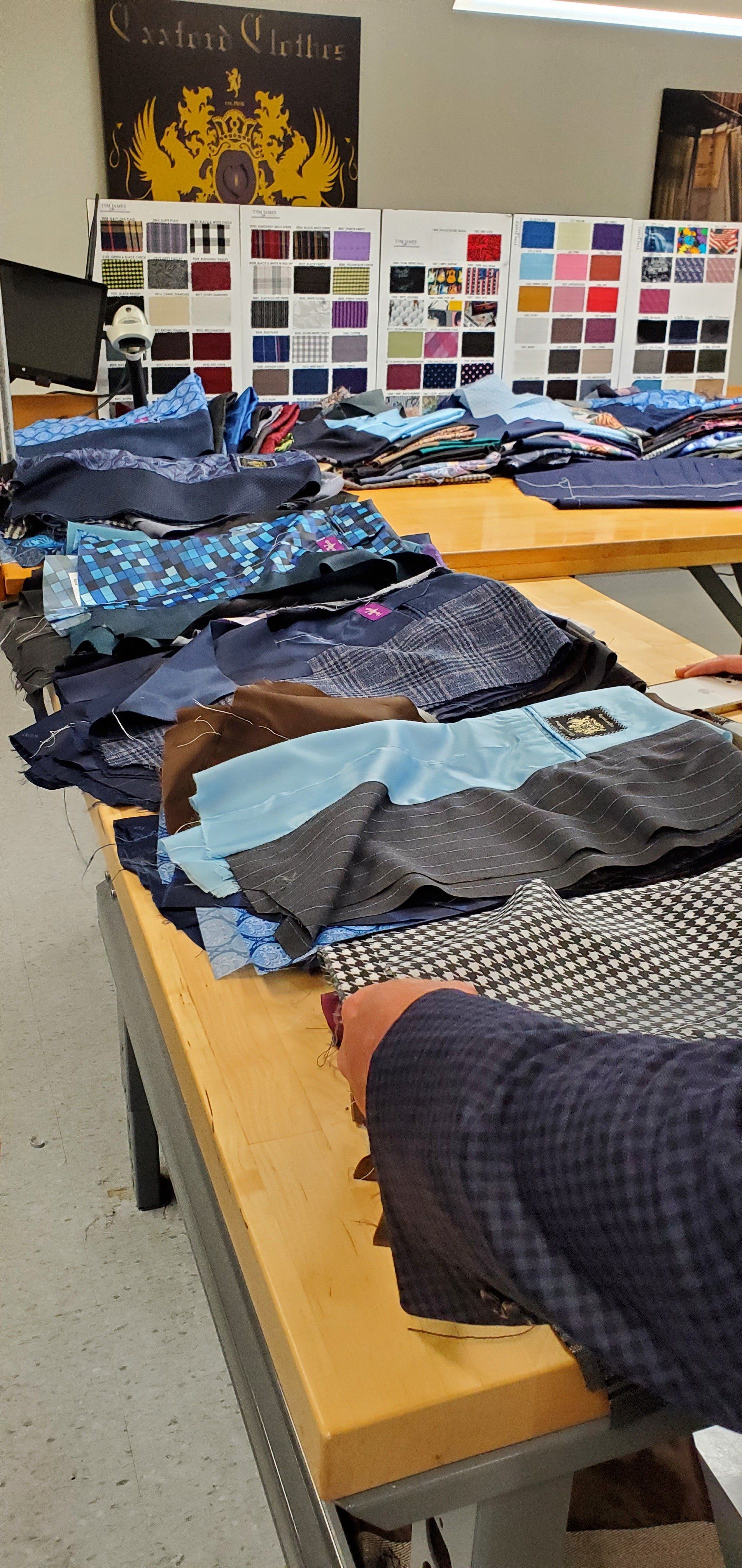
The flight is at 7AM from Chattanooga. A direct flight to Chicago that takes less than 90 minutes in the air. I arrive at the airport, go through security and I'm reading a book until 2 of my clients say hello. Duane and David arrive excited to tour the manufacturing facility. Oxxford Clothes is made like no other garment in the world. They are the epitome of fine tailored clothing. It was a rainy day when we touched the ground at O'Hare. We took the car to the facility, rain was decreasing. It turned into a nice day, for Chicago. We enter the building and are greeted. We are shown to the reception area, fitting rooms and showroom to look at fabrics. We look around and soon greeted by Nicole- Operations Manager. She gives us a tour first of the facility until Stanley is ready to fit their garments. We walk by many needleworkers doing numerous intricate tasks. I see the famous "Always Be Faithful to Quality" sign that is Oxxford's mantra. Nicole leads us to a room with two twenty five foot tables. Several bolts of fabric are on the table waiting for their turn at the blue pencil. The blue pencil is the simple task of drawing the pattern on the fabric for a desired garment. I say simple because the cutter also has to know how to match the pattern at all seams. They make it look effortless, but its far from easy and simply. There are boxes of tailors chalk, yardsticks, and huge shears on the table to complete this task. These shears are razor sharp, more than a foot long and heavy. This is all done by hand which is labor intensive. They also have big weights to hold down the pattern during the cutting process. Nicole tells us that each client can have their own pattern to be used for any and all orders. Nicole takes us into the pattern room. Its got some famous names and not so famous names in about 900 square feet. Each step in the process is important, but not being correctly cut and sized with perfect seams is not an option. This room is where more fabric can be wasted if this cutting is not perfect. We next go to where the lining for inside the coat is sewn. At first, one person makes a basting stitches on a machine to hold them together while still being able to complete hand work. Next to be added, lapel shape, shoulder pads, and pocketing on inside. Each part of the coat yous see and don't see has numerous steps involved. The average suit takes 2-3 hours total to sew together. The Oxxford Clothes take 29-30 hours of total time. That includes, sewing, pressing, and cutting. The shape of the lapels and collar are formed by a "skin" sewn into the garment. The skin or canvas is reinforced by a hand stitch to hold the shape of the lapel once its pressed. The number of stitches is about 2000, looks like a chevron pattern stitch. Most manufacturers glue this piece, the better companies sew it in by machine. Oxxford does this all by hand. The next area we go to is adding the strap on the lapel which reinforces the shape and roll. They sew in the buttonholes on the coat front and sleeves. And you can hear the hiss and hum of pressing machines throughout the floor. There are more pressing machines with shapers that set the roll, lapel angle and many other shapes. This process is time consuming to press and repress. Every step is completed by pressing the fabric and work. The sleeves still need to be added to the coat. They are sewn into the body using a fluid chain-loop stitch. The coat moves with the gentleman making every action flawless and free flowing. Other suits are stiff with the rigid construction and aren't as comfortable. When each front side, back, sleeves and collar are assembled, Stanley- Head Tailor- inspects every jacket. And if it doesn't pass, work is corrected. Oxxford's quality standards are the highest in the industry= "Meeting the demands of those in charge." Each piece has a spec sheet telling sizes, alterations, and lining number making sure its made correctly. We then have each client try on his coat and Stanley marks the alterations. Bruce and I at the store don't normally mark coats that small or close. We don't normally size jackets to be too small, but to fit closer not slim. But James, who just arrived, Duane and David are all under 50. Therefore they want this closer cut. Over the next hour, Stanley looks at every inch of the coats on each gentleman. He makes the necessary adjustments, alterations, and sizing so a pattern can be created. After today, they will have their "own pattern" for each future order. This exact pattern and sizing are another reason that make Oxxford Clothes truly unique. We like a more classic or timeless fit that most men can wear; not too full, not too skinny. After this informative series of measurements, we look a different fabrics in the showroom. They all fall in love with a 5 pocket style, and a few other items. Oxxford pants have another uniques construction, the pockets are part of the waistband. Therefore, they wear and move with you like nothing else. The fabric is a dark grey flannel, mid-weight which is perfect for the Chattanooga area. The other fine fabrics they look through include several well known mills: Holland & Sherry, Loro Piana, Dormeuil, Scabal, and an archival collection from the 1920s. Oxxford references the archives for any seasonal pieces which always refreshes the collection. It was an action packed day touring, fitting, and browsing fabrics. We make it back to Chattanooga. But not before looking around the showroom at fabrics and I see some incredible combinations. The fabrics are most appreciated felt and touched in person. I cannot convey adequately the softness and drape of the fabric, nor construction of garment in this blog. Please come see and feel for yourself.
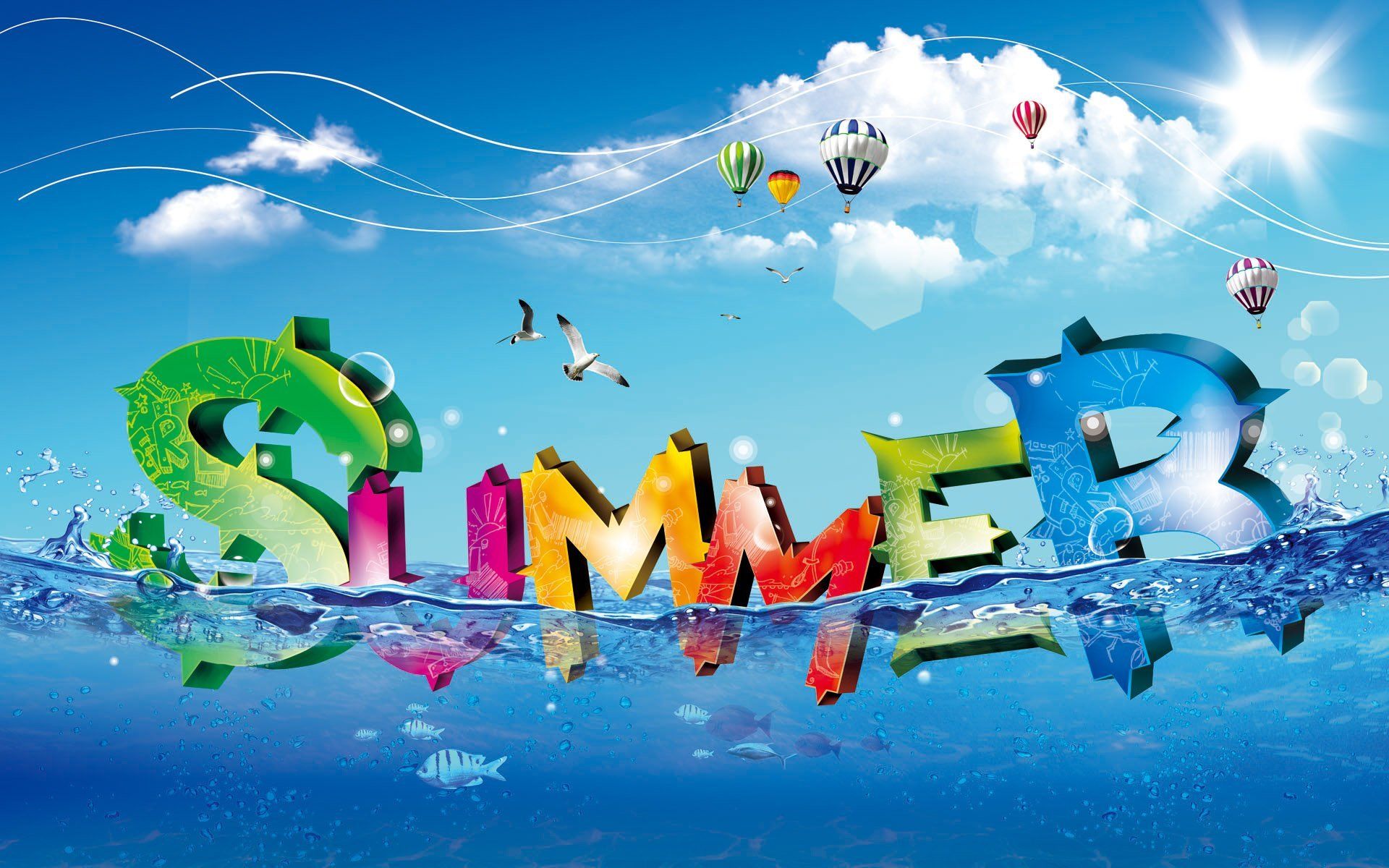
Summer vibes. Sun, surf, sand. Pool time. Beach time. Boat time. Sand between your toes. Relaxing days in the heat enjoying leisure time. Enjoying the sea breeze with no humidity. Lounging in the pool, l oving the sunshine of summer and long days. Spending time with family at home or away from home. I enjoy those times and being away from home to relax. Where do you enjoy your time? I've enjoyed theatre before Covid, enjoying free time, but still miss it. During this warm time, you can also learn new skills. When I was a kid, I learned to surf, boogie board, and tread water. I was 12 or 13 in San Diego. Had lots of fun on those long days. Lots of swimming in the ocean and bay. Still no expert in these skills, but I know how to do them. I even learned how to ski behind a boat in Watts Bar Lake in Tennessee. I respect the process and challenges of each. Its hard to surf in East Tennessee with or without a wet suit. Now it being 2021 and hopefully we've got past Covid-19 and the restrictions, we can still respect those wanting to maintain social distancing. Not everyone feels comfortable with the restrictions or them being lifted. Do what is right for you, but also be respectful of others. Now the test is to see how we can smartly gather with family and friends. The more important aspect of summer time or summer vacation is a break from your work and normal life. Go somewhere, do something different, and change up your whole schedule. Or slow way down from your busy life to doing absolutely nothing. Whatever it is, take a break from the norm. Vacations are only vacations when you reduce stress and then hopefully, you can enjoy doing something different. I always like to travel to see different places with family. And if we've been there, see something different so the experience is not the same. Then there are activities you're involved with where you meet people and make friends. We have them from all over the country. So we can travel and most likely see friends no matter where we go. It makes for great memories. Even mini adventures trying a winery or restaurant 60 minutes from where you live is a great new experience. Anything from the ordinary makes the extraordinary. How long does summer last? How long does it last for you? Look at a calendar and you get three different answers depending if you are a student or teacher, meteorologist or parent. Summer doesn't end until mid-September for the meteorologist which would make school kids and teacher very happy. One of my nephews started school back today, 8th grade. Too soon? But his district is more on the year round learning theory. I think in my day we went back right before or right after Labor Day. My kids went mid-August and got mid-May. As a kid, I knew once school started back, the summer was gone. As Calvin said(from Calvin and Hobbes ) "It's July already! Oh No! What happened to June?! Summer vacation is slipping through our fingers like grains of sand! It's going to fast!" Some people feel that, especially teachers. Summer often feels like it goes too fast.

I will not shave "economy" when "first class" is available. TAOS I will not let my son watch me shave with a plastic razor. TAOS I will discuss my love of shaving freely and without reservation. TAOS I will resist the urge to bring out my shaving brush at parties. TAOS Few skills in life learned early in life are used everyday. Shining shoes, giving a toast, building a campfire, hanging a picture, or giving a speech are skills men could use everyday, but most likely won't. Knotting a tie, shaking hands, making small talk, and performing a proper wet shave are the skills I use every day. So what is the makeup of a perfect shave? The path to smoothness is not hard, just an artful skill learned over a lifetime. We teach men how to improve their tie knot just like improving their shave. For guys, learning the shave is the fundamental rite of passage from boyhood to manhood. Men love the perfect shave. In an attempt to achieve optimal results while trying to maximize the comfort factor, we teach The Art of Shaving 4 step method and sell their products to achieve the comfort and smoothness. When using this method, your face will feel refreshed from using the unique combination of tools, products and techniques. Preparation is the most important step to lubricate the skin, hair and avoid irritation. It starts with proper grooming of your skin and your skin type. The Art of Shaving products has something for every skin type: oily, dry, normal, combination, sensitive, aging, and problem. Each of the Pre-Shave Oils, Shaving Creams or Soaps and After-Shave Balms all address the varying skin types. Know your products for your skin types whether it be Unscented, Sandalwood or Lavender. The most important thing is to wash your face with warm water before you shave. Set up your routine to wash your face in or out of the shower. After the shower, your skin will have been in the steamy water for 10 minutes and well prepared for shaving. I prefer to use the Unscented products so I can choose my cologne and not have scents mix. Applying just the right amount of Pre-Shave Oil can take some time to perfect. A little goes a long way when applying to the main five regions of your face. Around your mouth and chin, right cheek, below right jaw line and neck, left cheek, and below left jaw line and neck. The oil provides the maximum amount of protection so your razor blade glides effortlessly to cut the hair, but not the skin. Use natural oils, which is in The Art of Shaving products, so your skins pores do not become clogged. The use of the oil goes a long way to enhancing skin health. Massage it into your skin before applying the shaving cream or soap. Now you can Lather Up the shaving cream or soap. I've used both, but I prefer the soap at home to the cream. I get the same lather or better using my elbow grease while enjoying the process . When traveling its more convenient using the oil and then cream. At home, I lather up the soap with my fine badger-hair brush and apply it right after the oil. The cream gives a rich lather protecting the skin. Using a brush for either generates a warm lather, lifting the beard hair, and gently exfoliating the skin. And when lathering, a little soap or cream goes a long way. When using a brush, you distribute the shaving cream evenly and it gets underneath and around the hair. The brush does a better job applying than your fingers and results in a better shave. So, to this point you've been preparing the skin. Now we can get on with it and use the razor to shave. Shave with the hair growth and very smooth action. Go over the facial area only once or twice, any more will irritate the skin. You can use a straight razor(old school), safety razor, and multi blade razor. I feel comfortable using the safety razor at home and multi blade when traveling. I have not used the straight razor, that skill I reserve for the professional barber. I have a beard and mustache and still use this method around my face. Facial shave area is reduced to 4 sections- basically above and below the beard on each side of my face. But I have greatly reduced the possibility of irritation and ingrown hairs using the oil and soap. Still prepare your face with warm water to lather the product and get the hairs to stand up. To close the pores on your face, rinse the razor with cold water while shaving. It still gets the hair off and protects my skin. While shaving go around the face and finish above and below the mouth. Your chin will take the most skill and patience to complete shaving. And the total process of wet shaving should take 10 to 15 minutes. Last step to completing your shave and entering the world of smoothness is the correct moisturizes. The Art of Shaving recommends using their oil based After-Shave Balm. When applying like the oil & cream, a little goes a long way. Apply the balm after removing any excess shave cream and oil to ensure you soothe, nourish and moisturize the skin. Avoid balms that have any alcohol, even 2%. The last thing you want to do is irritate the skin and remove a layer of skin after you just removed a layer of skin while shaving. This will not result in smoothness; it can result in redness, irritation, ingrown hairs and razor burn. Always practice good techniques and patience when shaving. There are still challenges to shaving like around goatees or sideburns. However, the head shave becoming more popular in recent years still adheres to the same rules as the face. Use the Pre-Shave Oil, lather cream or soap, and reapply as needed. Always end with a good After-Shave Balm to moisturize the skin. Just as important, use a good razor and exercise patience. A good shave should take 10 to 15 minutes from start to finish. According to popular belief, there is no such thing as a quick shave. Hopefully, reading this will improve your skill of shaving to the land of smoothness. And with Father's Day on June 20th, we carry the full line of products from The Art of Shaving. Introduce your dad to the brotherhood of the Art of Shaving. Or help him improve and upscale his shaving game.
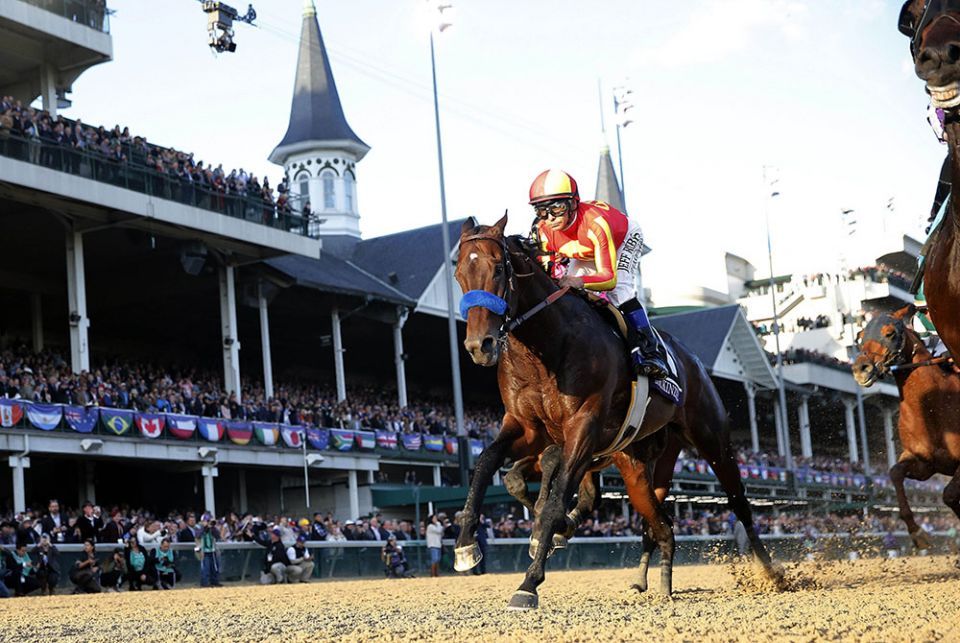
Roses. Twin Spires. Horse shoes. Mint Juleps. Jockeys. The roar of the crowd. The trumpeter playing the Call to the Post. The crowd singing "My Old Kentucky Home". These rich traditions transcend the Kentucky Derby from just a sporting event, making it a celebration of southern culture and a true icon of Americana. What else comes to mind when you think about the Kentucky Derby? The Fastest Two Minutes in Sports. The Running of the Roses. A field of 18 thoroughbreds running 1 1/4 mile to go down in history. The first leg of the Triple Crown. No race in American history captures the public's awe like the Kentucky Derby. And there is a short list of Triple Crown winners, which all starts at the Kentucky Derby. The Triple Crown of horse racing is considered one of the most difficult accomplishments in horse racing, and possibly all of sports championships. Secretariat's time at the Derby still stands from 1973. Being one of the most prestigious horse races in the world, it is no wonder why Churchill Downs draws such large crowds- 155,000. We look at the crowd to see the outfits. See who's wearing seersucker, linen, white buck shoes, suits, sportcoats, and hats. And we look to see who's wearing the brightest, most colorful, most outlandish outfit combinations. Not only is this the Super Bowl event of horse racing, it is for showcasing your fashion and people wearing there best. Its such a huge event and stage. Funny thing is they would wear things to the Derby that they would never wear to any other party. But that's the point. Look your best, stand out in the crowd. For many people, this is the beginning of the spring wearing season. There is so much history at Churchill Downs. It is a small and intimate track. I can only imagine the roar of the crowd from every spectator level. Visiting once in July, we went on the tour. Saw many statues, jockey colors display, the names of every winner since 1875, the areas where crowds could watch on TV and the betting cages. As you might expect the rose garden and museum are stunning. The Kentucky Derby is the oldest continuously running sports event in the U.S. A truly American race on the first Saturday in May every year. The rich and famous that mingle among the Derby Day crowd add a unique dimension to the spectacle. Movie moguls, recording artists, royalty, senators, comedians, actors, sport legends, and TV personalities all come to participate in the race and revel in the tradition. The red rose became the official flower of the Kentucky Derby in 1904. The Twin Spires on the new grandstand built in 1894 exemplify late 19th century architecture, in which symmetry and balance took precedence over function. Today, visitors from all over the world come to have their photos taken in front of the iconic Twin Spires. And then there's the excitement of the race. Which horse will win? That's why they run and call it the most exciting two minutes in sports. He's ahead by 2 lengths. Here they come down the stretch. This horse is ahead by 4 lengths and that by 8 and so on. The excitement by watching how it unfolds. And watching it on TV, if you step away for even a minute, then you can miss the move that sends a horse into history. Like Secretariat, he made his move on the final turn into the home stretch. Gaining and gaining to solidify his place in horse racing history. These were the first steps he took to secure being known as the greatest racehorse that ever lived.

Who do you think is the finest? I ask this question and you may think of cars? of banks? of colleges? No simply. . .Who makes the finest garment in the world? What sets them apart from every other clothing manufacturer? Oxxford Clothes is made in Chicago; not Italy or England. They are made completely by hand from cutting to final pressing. The motto- Always Be Faithful To Quality. The foundation of an Oxxford suit is steeped in impeccable hand construction which feels like no other because our garments are made like no other. Jacob and Louis Weinberg founded Oxxford Clothes in 1916 with a mission to establish the standard by which all men’s tailored clothing is judged. The Weinbergs were determined that no possible fineness in craftsmanship or material be overlooked in the achievement of that purpose. Today, the Oxxford mission remains unchanged. Since 1916, the world’s leading men have worn Oxxford for its elegance and character. Early on, gentlemen such as Clark Gable, Cary Grant, Walt Disney, and Joe DiMaggio chose Oxxford, and to this day, Oxxford’s client list reads like a “Who’s Who” of the world’s gentlemen. Today, men can still turn with full confidence to Oxxford Clothes, an institution which remains fully committed to its original mission: tailoring the clothing by which all others are judged. The two pillars of this handmade garment are construction and fabric. Using the finest materials in the garment's chest piece, shoulder pads, threads and intricate to the shape & longevity are second to none. The area of a sportcoat that generates the shape is stitched by hand with 2,950 stitches for balance: the collar and both sides of the lapel. Hand-stitched lapels and collars shape the cloth and inner linings together to create a graceful and elegant line. Hand basted shoulders and armholes, featuring a reverse chain stitch maintains the armseye rather than a binding tape which affords a softer feel and impeccable fit. All of these artisan methods contribute to the extraordinary suppleness and softness that you experience with Oxxford. Coupled with hand tailoring methods with the finest textiles, canvasses, shoulder pads, linings, silk thread, pocketing and more, results in a magnificent suit of clothes. The impeccability and attention to detail steeped in the construction can only be complimenting by the exclusive degree of fabric finesse. Only the finest, most choice, and hand selected wools will meet these demanding standards. Holland & Sherry is the finest fabric mill in England. They loom fine wools, cashmere, angoras, silks, vicunas, cottons, mohair, alpacas, linen,and silks to produce fabric bolts for making trousers, sportcoats, suits, topcoats, tuxedos or vests. The fabrics have been developed exclusively by Holland & Sherry and are renowned for holding their shape well when tailored. This quality alone allows for a smart bespoke, sculptured look; perfect for a stylish business image in any climate. Cashmere is the soft downy fleece of the cashmere goat whose rural habitat in Mongolia contributes to the cashmere's softness, fibre length, and ultra-fine micron. The soft downy fleece is protected by coarse guard hairs and is responsible for protecting the goat from the elements during the harsh Mongolian winter months. As the spring approaches, the soft downy fleece is no longer required and begins to shed naturally. At this time the Mongolian herders carefully gather the luxurious fibres by hand-combing their fleece; the process is slow and meticulous so no harm or stress is inflicted on the animal. Animal welfare is our main concern, and we can proudly state that the cashmere used in this collection is ethically and sustainably sourced. Once the combing process is complete, the tough outer guard hairs are separated and removed, leaving only the finest, softest cashmere fibres. Cashmere is one of the most valued and exquisite of animal hairs because of its incredible softness, making it one of the most sought-after and comfortable to wear. Transforming woven cashmere into luxurious finished product has remained unchanged for hundreds of years. The process of sorting, washing, drying and dyeing all labor to produce yarns which produce beautiful colors and patterns when loomed. The undercoats are generally white or black and respond well to the dyeing process. Any other fabrics used from Holland & Sherry are often exclusive to Oxxford Clothes meaning only they can produce your garment. For a clothing aficionado, there is nothing better than NOT seeing your sportcoat or pants walking down the street. Maybe something similar, but not quite the particular nuance of your fabric. And this is something men want, unusual clothing garments that are styled immaculately and unique to their wardrobe. Here at Oxxford we bring you the ultimate highest quality custom experience offering you USA's only true bespoke garments. It begins with an initial fitting with your tailor with detailed measurements and observations in body shape and preferences. A comprehensive review of textiles and a fabric selection along with a conversation in style is next. Your second fitting will ensure an impeccable fit, and revisions will be noted in sleeves and trouser inseams for the best placement. Finally, a final fitting is completed and the delivery of your unique garment. I wanted to invite you to look at these amazing fabrics during our exclusive spring showing on April 15. Come see their ability to hand make a superior, luxury product in the United States that sets them apart from everyone else. I look forward to showing you the most luxurious fabrics available from around the world to create a garment that is uniquely you.
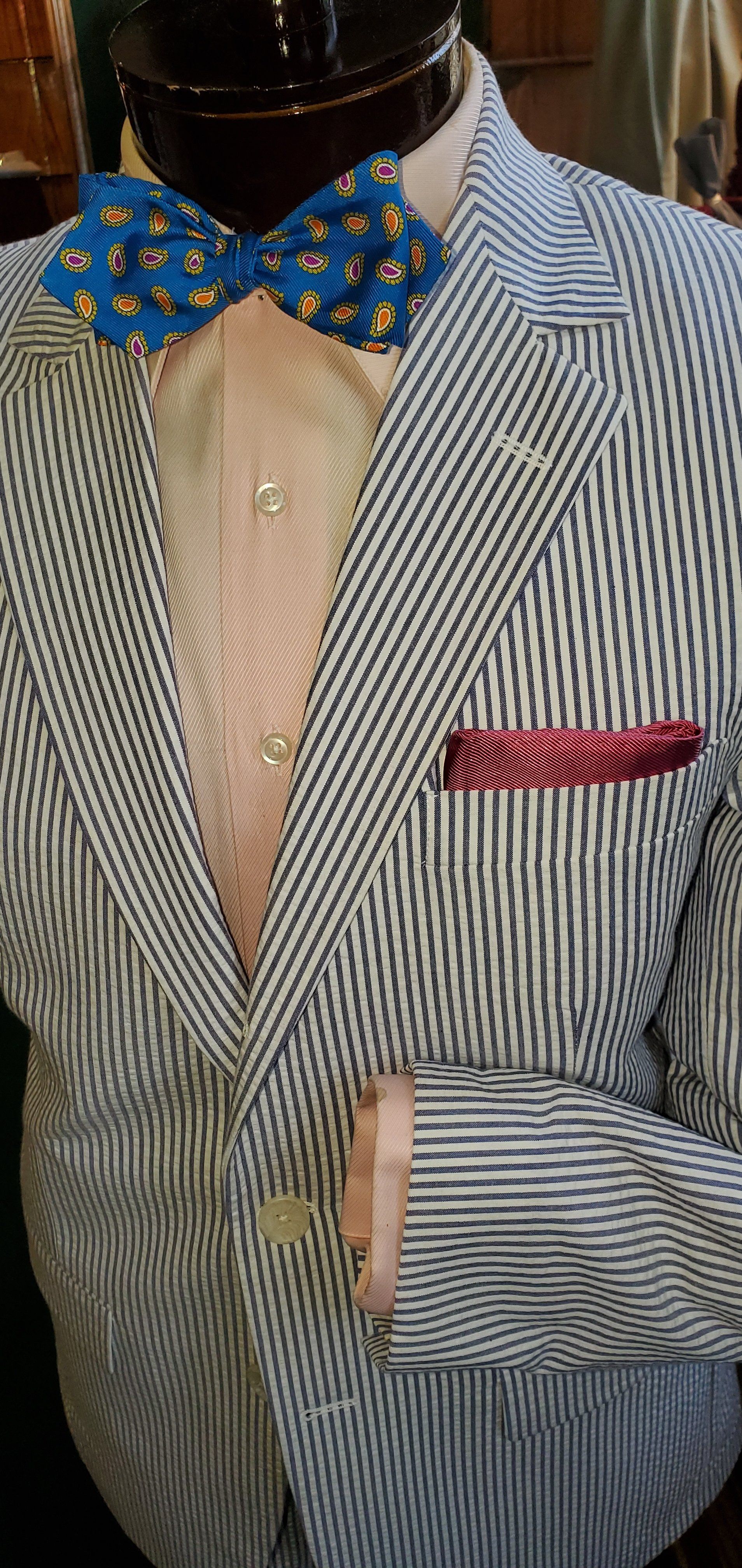
Spring t ime, we are now able to wear the linens, seersucker pants & suits, and white outfits. The warm weather is the return of long days, summer breezes(and heat) and a desire to be comfortable. Humans have known the cooling virtues of seersucker since the British colonial days and in the South. Often used as bed ticking during the Victorian age, the wealthy used it to stay cool during the socials, parties and galas. Therefore, a southern gentlemen was always dapper in his seersucker suit. I have worn a maroon & ivory, grey & white and the epitome of seersucker choice- the blue & white. I thought I liked them! But I have a client that has a pink & white, tan & white, orange & white, yellow & white, black & white, blue & white, white, and green & white seersucker suits. He didn't like the either purple nor red fabric we could get. He gets it, and loves seersucker for the summer. We know the fabric’s rise occurred around 1900 and then in the 1920s when it was used by preppy undergraduate college students and professors alike. Seersucker became a staple on college campuses across the US, particularly at Ivy League schools, where students often wore one seersucker garment (often, a blazer) whereas academic staff were known to wear full suits with a red bow tie. By the 50s, numerous companies such as Southwick and Hickey-Freeman were manufacturing all kinds of pieces, thus cementing its place in men's wardrobes. And during World War II, female officers in the Army, Navy & Marines, wore this striped summer fabric. Liking the aesthetics and qualities of it, nurses famously wore this fabric that became known as the "candy stripe." Servicemen remembered this fabric and that in part created the demand in the 1950s. Seersucker is a fabric that immediately sets a nostalgic feel- think Gregory Peck in To Kill A Mockingbird , or Matlock cross examining the witness that holds the key to the case. Social events like the Kentucky Derby, both men and women showcase their interpretation of the seersucker. Seersucker is worn by more celebrities and Senators then linens or white. There is something inherently congenial about seersucker that brings people together. In recent years, we've seen a return to popularity through movies- The Great Gatsby(2013) and Olympic athletes donning them for the team uniforms. It will never go away. We can make it for you in a classic fit or the updated slim fit in a variety of colors. Turning to linen, the very thing that hate about linen is the inherent feature that tells you you're wearing linen; the wrinkles. It is another summertime fabric that people love or hate. And in The Great Gatsby(2013) , Southwick made ten pink linen suits for Leonardo DiCaprio to always look fresh and not wrinkled. Most common wares for linen is trousers and shorts for men; skirts for women. A linen suit or sportcoat is for the gentleman that loves linen and the wrinkles. Linen trousers give your navy blazer a summer time feel for any soiree or gathering. And white is best loved in cotton or tropical weight wool. White linen is another epitome of a gentlemen's dapper look. Now we see seersucker made anyway you can imagine: bow ties, shirts, girls dresses, boys shorts, shorts, trousers, ladies skirts & dresses, and men's suits & sportcoats. We love the summer fabrics and can't wait to wear them. You won't fully appreciate it until you are comfortable in the muggy summer heat.
